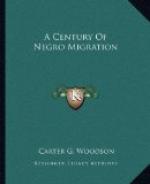Some Negro slaves unwilling to wait to be carried or invited to the Northwest Territory escaped to that section even when it was controlled by the French prior to the American Revolution. Slaves who reached the West by this route caused trouble between the French and the British colonists. Advertising in 1746 for James Wenyam, a slave, Richard Colgate, his master, said that he swore to a Negro whom he endeavored to induce to go with him, that he had often been in the backwoods with his master and that he would go to the French and Indians and fight for them.[20] In an advertisement for a mulatto slave in 1755 Thomas Ringold, his master, expressed fear that he had escaped by the same route to the French. He, therefore, said: “It seems to be the interest, at least, of every gentleman that has slaves, to be active in the beginning of these attempts, for whilst we have the French such near neighbors, we shall not have the least security in that kind of property."[21]
The good treatment which these slaves received among the French, and especially at Pittsburgh the gateway to the Northwest Territory, tended to make that city an asylum for those slaves who had sufficient spirit of adventure to brave the wilderness through which they had to go. Negroes even then had the idea that there was in this country a place of more privilege than those they enjoyed in the seaboard colonies. Knowing of the likelihood of the Negroes to rise during the French and Indian War, Governor Dinwiddie wrote Fox one of the Secretaries of State in 1756: “We dare not venture to part with any of our white men any distance, as we must have a watchful eye over our Negro slaves, who are upward of one hundred thousand."[22] Brissot de Warville mentions in his Travels of 1788 several examples of marriages of white and blacks in Pittsburgh. He noted the case of a Negro who married an indentured French servant woman. Out of this union came a desirable mulatto girl who married a surgeon of Nantes then stationed at Pittsburgh. His family was considered one of the most respectable of the city. The Negro referred to was doing a creditable business and his wife took it upon herself to welcome foreigners, especially the French, who came that way. Along the Ohio also there were several cases of women of color living with unmarried white men; but this was looked upon by the Negroes as detestable as was evidenced by the fact that, if black women had a quarrel with a mulatto woman, the former would reproach the latter for being of ignoble blood.[23]
These tendencies, however, could not assure the Negro that the Northwest Territory was to be an asylum for freedom when in 1763 it passed into the hands of the British, the promoters of the slave trade, and later to the independent colonies, two of which had no desire to exterminate slavery. Furthermore, when the Ordinance of 1787 with its famous sixth article against slavery was proclaimed, it was soon discovered that




